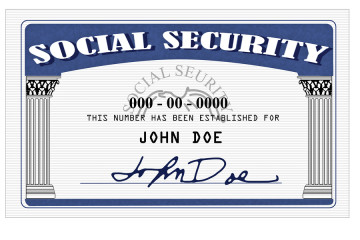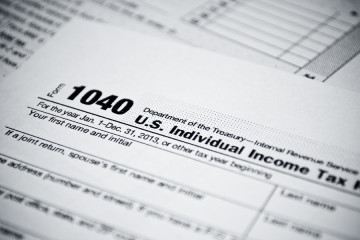Happy 80th Birthday, Social Security. Your Gift? My Plan Not to Need You (So Much)

©2015 Bloomberg News
NT1S1H6KLVR4
(Bloomberg Business) — It’s Social Security’s 80th birthday, and while news about the program’s financial status is rarely happy, most Americans are very thankful it still exists. Women and lower-earning workers in general rely particularly heavily on the program for income in their old age.
But with constant talk of the program being underfunded, and with it under constant political attack, focusing on a Plan B to boost future retirement income—which has the great advantage of being largely under your own control—is more important then ever. Here are eight ways, one for each decade of Social Security’s existence, to firm up your financial footing now.
First, though, take a look at this chart from the National Academy of Social Insurance. It shows, roughly, how the Social Security program replaces more than 50 percent of income for low-earning workers, and also what high-earners could be up against if they someday needed to rely heavily on income from the program. (A major lifestyle change, to say the least.)
The Social Security Administration calculates income replacement rates for retired workers, assuming 35 years of contributing to the program, and bases that on its national average wage index (AWI). For 2015, the AWI is $47,820.
Since many people expect future Social Security benefits to be continue to be trimmed, being proactive is the way to go. Here are ways you can improve the odds that, when the time comes, getting those Social Security wages you paid in will be nice, but not absolutely necessary. 1. Wage war on fees
This means, first, knowing what fees you are paying for different investment accounts. Many people have no idea, particularly when it comes to retirement savings accounts such as 401(k) plans. A Department of Labor rule about how plans must provide participants with fee disclosure has made that information more easily available.
Once you find that information, your plan probably won’t note whether those fees are low, average or high compared to similar funds. One way to find out is to check out a service offered by an Israeli startup named FeeX. Users create an account and connect it to their old and new 401(k) plans. FeeX automatically calculates how much, if anything, a rollover into an IRA, or a switch into a plan’s cheaper fund options, could save in fees.
I tested it out with funds I own in the Bloomberg LP 401(k) plan. It flagged the Harbor International Institutional fund (HAINX), an actively managed fund, which has an annual fee of 0.75 percent. It calculated that, over a couple decades, I could save $10,864 by switching to a lower-cost alternative in my plan, the Vanguard Developed Markets Index Institutional (VTMNX). Vanguard’s fund charges 0.07 percent annually.2. Get the mix right
If you have multiple investment accounts outside your 401(k), or just multiple 401(k)s, it can be hard to know what percentage of your assets are in cash equivalents, bonds and stock. What is the optimal mix? Everyone’s situation and risk tolerance (more on that in a second) is different, but the asset allocation in target-date funds gives a sense for what some large investment companies think is ideal.
For someone who is about 45, and wants to retire in 20 years, the asset mix in the Fidelity Freedom Fund 2035 is 90 percent in stocks and 10 percent in bonds. Ten years in, the stock portion will drop to 70 percent, bonds will be 28 percent, and 2 percent will be in short-term funds. At 2035, when the accountholder is 65, the stock/bond/short-term funds split is 56, 34 and 11. The net expense ratio is 0.16 percent.
Many people think they should start dialing back on equities when they’re 10 years away from retirement. Problem is, if you pare stocks dramatically at age 55 and live 30 more years, your saving may run out. That said, if you suspect you would panic and sell into any dramatic drop in the market—think back to how you felt and what you did in 2008—moving some money out of equities makes sense. 3. Know your risk tolerance
Financial advisors will say that clients overestimate their risk tolerance, but FinaMetrica, a firm that runs psychometric risk tolerance tests, says it’s the advisors who become more nervous than they expected when markets become volatile.
Finametrica also says most people are actually pretty good at assessing their own risk tolerance. I am apparently not one of them. I took the company’s 25-question test(anyone willing to pay $45 can take it, or ask his or her advisor to spring for it). After estimating I’d score at 45, I scored 39 out of 100, lower than 85 percent of all scores. As the test report put it, “Most people under-estimate their score by a few points. However, yours was an over-estimate. When compared to others you are somewhat less risk tolerant than you thought you were.”
To guard against getting too stressed by market swings, investors may want to separate their money into different buckets. Money can be tied to short-, medium- and long-term goals, with each bucket having a different risk profile, says financial advisor Curt Weil. If the market’s swinging wildly and you know your immediate needs are covered in a short-term, conservatively invested bucket, you may feel more comfortable sticking with any higher-risk, higher-return investments in the long-term basket. 4. Save until it hurts
If you’re lucky to be at a company that offers a 401(k), you may already be funneling money into it every pay period. Hopefully, you can save enough to get all of any company match. Saving 12 percent to 15 percent of your salary in a 401(k), up to the 2015 contribution limit of $18,000, is what many financial planners suggest. (That assumes you already have a cash emergency fund of three months at the very minimum.)
If your budget allows, try setting up automatic deductions from your checking account into other savings accounts, even if it’s just $25 or $50 a paycheck. And if you don’t notice that it’s gone, kick the contribution up a little higher.
If you want someone else to save your money for you, a growing number of online financial companies are offering up programs to “personalize” savings. They’re doing this with software that assesses how much you need to keep in checking to pay bills, and then automatically spiriting the excess into savings or investment accounts. Companies with products like this include Betterment and Digit. 5. Consider 401(k) money sacrosanct
One challenge millennials face that their parents didn’t is handling 401(k) accounts while moving jobs every two to three years. Rather than roll an old 401(k) into a new employer’s plan, many young savers just cash it out, which means paying income tax on it and a 10 percent penalty.
In the year ended Mar. 31, 2015, more than 40 percent of 401(k) participants between the ages of 20 and 29 cashed out all or part of their plan balance after leaving a job, according to Fidelity. Even for those between the ages of 40 and 49, the cash-out percentage was high, at 32 percent.
Barring a lottery win or inheritance, starting to save early so money can compound over many decades is really the only way most younger savers are going to arrive at retirement age with a decent nestegg.6. Become an employee benefits ninja
If you’re offered a flexible spending program, health savings account or the ability to pay your commuting costs with pre-tax money, take the time to read about them. You’ll get more mileage out of your money, and lower your income taxes to boot. Making the most of tax-advantaged perks is a small way to give yourself a raise in a time of stagnating wages.
Employers have been shifting more costs to employees, often through the use of high-deductible health-care plans. The adoption of the plans by companies may slow next year, according to a survey of more than 100 large U.S. employers. Employers are waiting to see if lawmakers repeal Obamacare’s “Cadillac tax” on high-cost health coverage, which is a levy on individual health premiums greater than $10,200.
As Bloomberg’s Zachary Tracer and Richard Rubin wrote recently, “The tax was a key feature of 2010’s Patient Protection and Affordable Care Act, designed to pressure overall health-care costs. And since health insurance isn’t taxed as income, employers have had an incentive to provide more health insurance, and less wages, than they otherwise would.” A roll- back would keep employers from having to shift workers into plans where they bear more of the up-front costs of their insurance.
Health care savings accounts (HSAs) go hand in hand with high- deductible health plans. They are “triple tax-free”—what you put in is sheltered from income tax, it grows tax-deferred and the money can be used, tax-free, for medical expenses. Companies usually seed the accounts with a few pre-tax hundred dollars, and your contributions are tax-deductible. You can contribute up to $3,350 for an individual policy, and $6,650 for a family plan. And unlike flexible-spending programs, they are not “use it or lose it,” so your money accumulates.7. Avoid the fancy stuff
There are many benefits to keeping your finances fairly simple, such as having a clear picture of where you stand. Unless you’re a seasoned speculator whose retirement is already more than provided for, avoid any investment with the word “leverage” or 2x or 3x (or more) in its name. It’s been said before, but it bears repeating: If you don’t understand it, don’t buy it. 8. Eat your spinach
Healthcare costs in retirement are the most likely thing to send your finances into the depths of hell. Fidelity estimates that in 2014 a couple who retired at age 65 could look forward to $220,000 (in today’s dollars) in health care costs. That number didn’t rise from 2013, but it’s still way more than most people have saved for all of their retirement.
There are many interactive calculators that will effectively scare you into going to the gym if you aren’t already. (It’s like making money!) The AARP has a pretty simple calculator, and there are many others.
Truth be told, I should have switched into the Vanguard index fund long ago, simply because most actively managed funds cannot consistently outperform the market. While Harbor has handily outperformed the Vanguard fund over 10 years—7.4 percent compared to 4.6 percent—the Vanguard fund’s returns have been similar or better in the past five years. Vanguard wins on fees.
Vanguard’s 2035 target date fund takes a more conservative approach. It starts with 82 percent in stocks and 18 percent in bonds, and in 2025 assets should stand at 66.8 percent stocks and 33.2 percent bonds. Its expenses are 0.18 percent. Those over age 50 can make additional “catch up” annual contributions of $6,000. Another challenge younger savers face that their parents may not have is tied to the the trend to auto-enroll employees in 401(k) plans. That has]had a big impact on worker participation, but can get a little tricky with job-hoppers. If someone managed to get up to, say, saving 7 percent of their salary, when they move to a new job they may get auto-enrolled at the typical and way- too-low rate of 3 percent and not get around to bumping it up. To contact the author on this story: Suzanne Woolley at swoolley2@bloomberg.net To contact the editor on this story: Peter Jeffrey at pjeffrey@bloomberg.net







No Comment